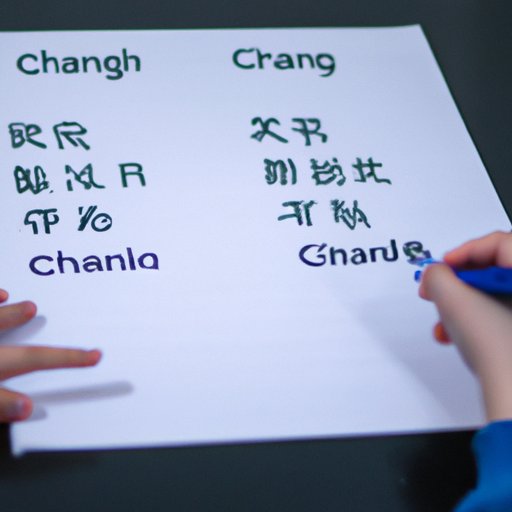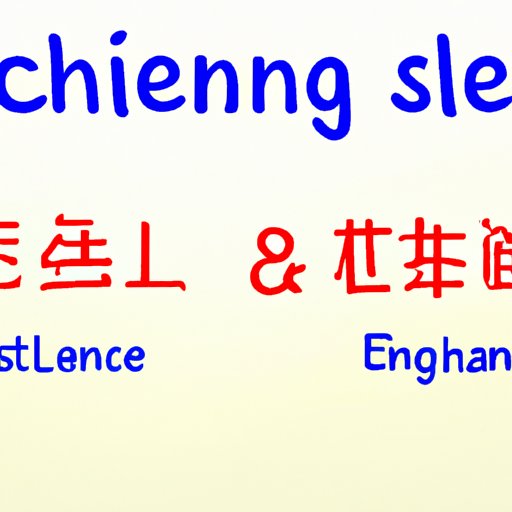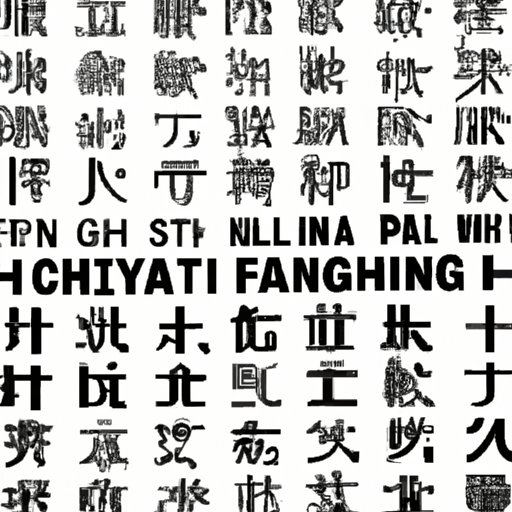Introduction
The Chinese and English writing systems are two of the most widely used written languages in the world. Although they have many similarities, there are also a number of differences that distinguish them from one another. This article will explore these differences by examining the number of characters in each language, the different writing styles, the complexity of Chinese characters compared to English letters, and the role of grammar and culture in both languages.

Exploring the Difference Between Chinese and English Writing Systems
In order to understand the differences between Chinese and English writing systems, it is important to first have a basic understanding of how they work. Chinese writing relies heavily on characters, which are pictograms or ideograms that represent ideas or concepts. English writing, on the other hand, is based mainly on letters that form words. Both writing systems use symbols to represent the spoken language, but the way these symbols are used is very different.
Overview of Chinese Characters
Chinese characters are made up of several components, including strokes, radicals, and phonetics. Strokes are the individual lines that make up a character, while radicals are the parts of a character that give it its meaning. Phonetics are the sounds associated with certain characters, and they help to distinguish characters that are similar in appearance. Chinese characters can be combined to form compound words, and they can also be used to write phrases and sentences.
Overview of English Letters
English letters are used to form words, and these words can be combined to create phrases and sentences. Each letter has its own sound, and these sounds can be combined to create words. English letters can also be combined to form contractions, which are shortened versions of words or phrases. English writing also uses punctuation marks, such as periods, commas, and question marks, to clarify the meaning of sentences.
Comparing the Number of Characters in Chinese and English Writing
The Chinese writing system consists of more than 50,000 characters, while the English alphabet only contains 26 letters. However, this does not mean that Chinese is necessarily more complex than English. In fact, the average Chinese reader only needs to know around 3,000 characters in order to be able to read most written material. Furthermore, Chinese characters often contain multiple meanings, so a single character can represent a variety of ideas or concepts.

Understanding the Different Writing Styles of Chinese and English
Chinese characters are written in a brush-style, meaning that they are written with a brush or pen in a continuous, flowing motion. English letters, on the other hand, are written in a block-style, which means that they are written with a pencil or pen in distinct, separate strokes. The brush-style of Chinese characters allows for more fluidity and creativity when writing, while the block-style of English letters results in a more structured and organized writing style.
Examining the Complexity of Chinese Characters Compared to English Letters
When comparing the complexity of Chinese characters to English letters, it is important to note that Chinese characters are generally much more complex than English letters. Each Chinese character is made up of several components, while English letters can usually be broken down into just one or two components. Moreover, Chinese characters often have multiple meanings, while English letters have only one meaning each.
Analyzing the Role of Grammar in Chinese and English Writing
Grammar plays an important role in both Chinese and English writing. In Chinese, grammar rules include the use of particular characters to indicate specific meanings, as well as the correct placement of characters in relation to each other. In English, grammar rules involve the proper use of punctuation marks and the correct conjugation of words. Both Chinese and English writing also rely on context to convey meaning.

Investigating How Different Cultures Influence the Writing of Chinese and English
The Chinese and English writing systems have been shaped by the cultures in which they were developed. For example, Chinese characters were originally used to record events and tell stories, while English letters were used to communicate information. As a result, Chinese writing often has a poetic and artistic quality, while English writing tends to be more straightforward and logical. Additionally, Chinese writing has been influenced by Confucianism and Taoism, while English writing has been shaped by Christianity.
Conclusion
The Chinese and English writing systems have many similarities, but there are also a number of differences that distinguish them from one another. These differences include the number of characters in each language, the different writing styles, the complexity of Chinese characters compared to English letters, and the role of grammar and culture in both languages. By understanding these differences, we can better appreciate the unique qualities of each written language.
Final Thoughts
The Chinese and English writing systems are two of the most widely used writing systems in the world. They share many similarities, but there are also a number of differences that set them apart. By exploring these differences, we can gain a better appreciation for the uniqueness of each writing system, and how it has been shaped by the culture in which it was developed.
(Note: Is this article not meeting your expectations? Do you have knowledge or insights to share? Unlock new opportunities and expand your reach by joining our authors team. Click Registration to join us and share your expertise with our readers.)
